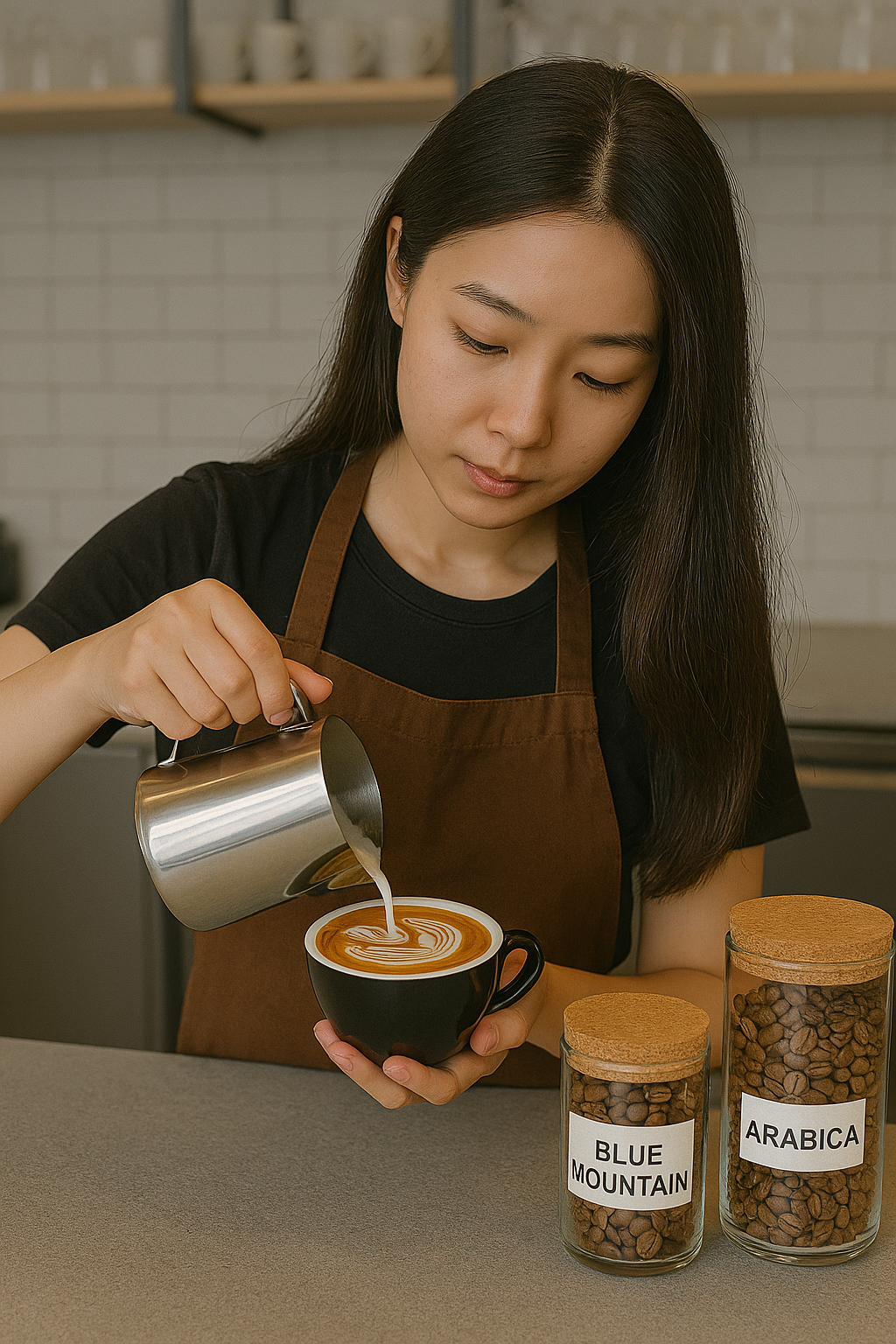How to Store SOE Single Origin Espresso for Optimal Freshness
How to Store SOE Single Origin Espresso for Optimal Freshness
Blog Article
Exploring the Rich Tastes of Coffee Beans: a Deep Dive Into Coffee and Blended Coffee Beans
When you explore the rich flavors of coffee beans, you uncover a complex globe where each selection brings its own character to your mug. Recognizing the origins, refining techniques, and toasting strategies can change your coffee experience. As you browse with the art of espresso and the creativity behind combined coffees, you'll start to appreciate the subtleties that make each sip distinct. What you'll discover next could transform the method you enjoy your early morning brew.
The Origins of Coffee Beans: Exploring Terroir and Taste Profiles
When you take a sip of coffee, you're not simply appreciating a beverage; you're experiencing a rich tapestry of flavors formed by the beans' beginnings. Each area produces one-of-a-kind taste accounts influenced by climate, altitude, and dirt. For instance, beans from Ethiopia usually break with intense, fruity notes, while those from Colombia have a tendency to use a balanced, nutty sweet taste.
As you discover different origins, you'll notice just how terroir-- the environmental variables influencing a plant-- plays a vital function - Single Origin Espresso. The same coffee range can taste substantially different depending on where it's expanded
When you think about these aspects, you start to appreciate the complexity behind your mug. Each sip narrates of the land and the farmers who nurtured the beans. Next time you indulge, believe regarding the trip your coffee took prior to it reached your hands, and appreciate those complex flavors that reflect its origin.
Recognizing Espresso: The Art and Science Behind the Brew
When you think about espresso, it's not almost the strong taste; it's additionally about the methods that bring it to life. Recognizing exactly how different preparation techniques impact taste can change your brewing experience. Let's discover the details of coffee prep work and uncover the special taste profiles that make each mug unique.
Espresso Preparation Strategies
Espresso prep work is both an art and a scientific research, integrating exact methods with a deep understanding of coffee. To start, you'll wish to choose high-grade, freshly roasted beans and grind them finely for excellent removal (Single Origin Espresso). The grind size is vital; also crude, and your coffee will certainly be weak, too fine, and it'll be bitter
Following, tamp the grounds evenly in the portafilter to guarantee uniform extraction. When you lock it right into the equipment, go for a developing temperature level between 190 ° F and 205 °
F.As you draw the shot, expect the best removal time-- around 25-30 secs. The result needs to be a rich, creamy coffee with a gorgeous layer of crema on top. With method, you'll master these strategies.
Flavor Accounts Discussed
The globe of coffee provides an abundant tapestry of flavor accounts that can boost your coffee experience. When you take that initial sip, you'll discover an equilibrium of resentment, sweet taste, and acidity. Each coffee bean lugs one-of-a-kind notes, from fruity and flower to nutty and chocolaty. Light roasts commonly showcase bright acidity and vibrant flavors, while dark roasts present much deeper, bolder tones.
A well-crafted blend might balance the intense notes of an Ethiopian bean with the rich, chocolatey touches of a Brazilian bean. Welcome the trip of finding espresso's varied tastes, and you'll transform your coffee ritual into an exciting journey.
Processing Methods: How They Impact Taste and Aroma
While it might appear that the origin of coffee beans is the most substantial consider identifying their flavor and fragrance, the handling methods made use of post-harvest play a just as crucial duty. You'll discover that these methods can drastically alter the last taste account of your cup.
As an example, the washed process gets rid of the fruit from the beans prior to fermentation, typically bring about a cleaner, brighter flavor. The natural procedure leaves the fruit intact throughout drying, resulting in a sweeter, fruitier account.
Various other techniques, like honey handling, strike a balance, allowing some fruit mucilage to remain, offering a distinct intricacy.
Each handling technique interacts with the beans' inherent features, improving or silencing particular flavors and scents. So, when you drink that espresso or combined coffee, bear in mind that the journey from cherry to mug is influenced not just by beginning yet also by exactly how those beans were refined.
Toasting Methods: Unlocking the Complete Potential of Coffee Beans
Roasting strategies are vital for SOE exposing the full potential of coffee beans, as they transform raw, environment-friendly beans into the fragrant, savory coffee you appreciate. The option of toasting technique-- light, medium, or dark-- significantly influences taste profiles. Light roasts protect the beans' all-natural level of acidity and fruity notes, while tool roasts equilibrium sweet taste and richness. Dark roasts, on the various other hand, emphasize bold, smoky flavors.
A slower roast at reduced temperature levels permits for intricate flavors to develop, while a quicker roast can magnify bitterness. By grasping these techniques, you'll reveal a globe of taste, elevating your coffee experience to brand-new heights.
The Magic of Blended Coffee: Creating One-of-a-kind Taste Experiences
Producing an unique taste experience with combined coffee can transform your early morning ritual into an expedition of taste. By combining various beans from numerous areas, you can expose a symphony of flavors that elevate your cup to new elevations. Each blend deals a distinct account, stabilizing sweetness, body, and acidity to develop something genuinely unique.
When you choose a mix, you're not simply choosing a coffee; you're selecting a journey throughout varied landscapes and societies. Try out various mixes permits you to find your individual favorites, whether you enjoy fruity notes or rich, chocolatey undertones.

Sampling Notes: Identifying the Subtleties in Your Mug
As you sip your coffee, you might discover a range of flavors dancing on your taste buds, each revealing the details of the beans. You may taste the bright acidity evocative citrus or the deep, rich notes akin to dark chocolate. The sweet taste could evoke honey or caramel, balancing the overall profile magnificently.
Pay focus to the body of the coffee-- does it really feel light and ventilated, or is it complete and luscious? The coating, as well, offers clues; a remaining aftertaste may mean nuttiness or floral undertones.

Don't neglect to discover the special features of various origins, as each region presents unique flavors - Single Origin Espresso. For instance, Ethiopian coffees typically present fruity notes, while Colombian beans could showcase an extra spherical sweetness. By recognizing these nuances, you'll deepen your admiration for every cup, boosting your coffee experience to new heights

Brewing Methods: Taking Full Advantage Of Flavor Removal for every single Bean
When you check out the various developing methods, you'll uncover that each strategy can substantially influence the flavor account of your coffee. From French press to pour-over, each method essences various compounds, improving or silencing particular notes. Making use of a French press enables oils to continue to be in the brew, developing a richer taste, while pour-over stresses clearness and illumination.
Temperature and grind dimension also play important roles. A coarser work functions best for chilly mixtures, while a fine grind is perfect for coffee. Exploring with water temperature level-- between 195 ° F and 205 ° F-- can disclose hidden tastes, as well.
Do not ignore soaking time; a quick extraction can lead to sour notes, while over-extraction may generate bitterness. By changing these variables, you can optimize flavor extraction and really raise your coffee experience. Enjoy the journey of discovering what method best suits your palate!
Frequently Asked Questions
What Is the Ideal Water Temperature for Developing Coffee?
The optimal water temperature level for developing coffee's in between 195 ° F and 205 ° F. If you use water that's too hot, you'll over-extract tastes; also cold, and you won't draw out sufficient. Go for that sweet place for the very best mixture!
Just How Does Work Size Affect Coffee Flavor?
Work dimension considerably impacts coffee taste. Finer grinds remove more oils and tastes, leading to a bolder taste, while coarser grinds yield a lighter taste. Readjusting grind size helps you attain your wanted coffee account.
Are There Health Benefits Surrounding Drinking Coffee?

What Is the Distinction In Between Arabica and Robusta Beans?
Arabica beans are smoother and sweeter, often featuring fruity tastes, while robusta beans are stronger with a bitter taste and higher caffeine content. You'll notice these differences in fragrance and brewing experience.
How Can I Store Coffee Beans for Freshness?
To store coffee beans for freshness, maintain them in an airtight container, away from moisture, warm, and light. If you just grind what you require right before developing., you'll preserve their flavor much longer.
Checking Out the Abundant Tastes of Coffee Beans: a Deep Dive Into Espresso and Blended Coffee Beans.
When you explore the abundant tastes of coffee beans, you uncover an intricate globe where each selection brings its very own character to your cup.When you take a sip of coffee, you're not simply delighting in a beverage; you're experiencing an abundant tapestry of flavors shaped by the beans' beginnings.Roasting methods are essential for disclosing the complete capacity of coffee beans, as they transform raw, green beans into the fragrant, flavorful coffee you delight in.As you drink your coffee, you could notice a spectrum of flavors dancing on your taste buds, each disclosing the complexities of the beans.
Report this page